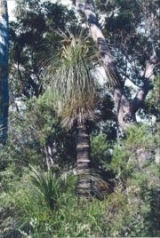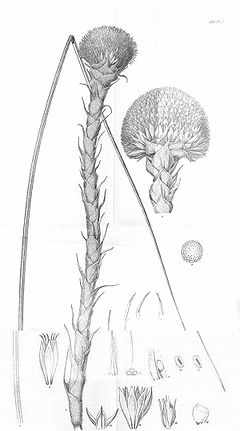
Kingia
Encyclopedia

Genus
In biology, a genus is a low-level taxonomic rank used in the biological classification of living and fossil organisms, which is an example of definition by genus and differentia...
of the plant family Dasypogonaceae
Dasypogonaceae
Dasypogonaceae is a botanical name of a family of flowering plants. Such a family has not been commonly recognized by taxonomists: the plants involved were usually included in the family Xanthorrhoeaceae....
, consisting of a single species Kingia australis. It has a thick pseudo-trunk consisting of accumulated leaf-bases, with a cluster of long, slender leaves on top. The trunk is usually unbranched, but can branch if the growing tip is damaged. Flowers occur in egg-shaped clusters on the ends of up to 100 long curved stems. Kingia grows extremely slowly, the trunk increasing in height by about 1½ centimetres per year. It can live for centuries, however, so can attain a substantial height. 400 year old plants with a height of six metres are not unusual.
When not flowering, Kingia australis bear a superficial similarity to species of the genus Xanthorrhoea
Xanthorrhoea
Xanthorrhoea is a genus of flowering plants native to Australia and a member of family Xanthorrhoeaceae, being the only member of subfamily Xanthorrhoeoideae. The Xanthorrhoeaceae are monocots, part of order Asparagales. There are 28 species and five subspecies of Xanthorrhoea.-Description:All are...
, some of which bear the common name "blackboy" because of their purported similarity to an Aboriginal boy holding an upright spear. However, the flower stalks of Kingia australis are completely different from that of Xanthorrhoea species. Because of this, Kingia australis was for many years thought to be a female form of the blackboy and was commonly named black gin, "gin" being the Nyoongar
Noongar
The Noongar are an indigenous Australian people who live in the south-west corner of Western Australia from Geraldton on the west coast to Esperance on the south coast...
word for "woman". This remains the most widely known common name, although some now consider the name inappropriate or at least belonging to the past. The genus name Kingia or the Aboriginal name bullanock are now preferred.
Kingia and Xanthorrhoea are biologically quite distinct and are not closely related. For example, Xanthorrhoea have a secondary thickening meristem in the trunk (Dracaenoid secondary thickening meristem
Meristem
A meristem is the tissue in most plants consisting of undifferentiated cells , found in zones of the plant where growth can take place....
), whereas Kingia lack this feature.
Taxonomic history

Robert Brown (botanist)
Robert Brown was a Scottish botanist and palaeobotanist who made important contributions to botany largely through his pioneering use of the microscope...
at King George Sound
King George Sound
King George Sound is the name of a sound on the south coast of Western Australia. Located at , it is the site of the city of Albany.The sound covers an area of and varies in depth from to ....
in 1801. The plant featured in the drawing View of the south side of King George's Sound by expedition artist William Westall
William Westall
William Bury Westall was an English novelist born in Old Accrington, Lancashire, England.Originally a businessman, he later became a journalist who also wrote about 30 pot-boiler romantic novels with titles including The Old Factory, Strange Crimes and Her Ladyship's Secret...
, which was later published as a plate in Matthew Flinders
Matthew Flinders
Captain Matthew Flinders RN was one of the most successful navigators and cartographers of his age. In a career that spanned just over twenty years, he sailed with Captain William Bligh, circumnavigated Australia and encouraged the use of that name for the continent, which had previously been...
' 1810 A Voyage to Terra Australis
A Voyage to Terra Australis
A Voyage to Terra Australis: Undertaken for the Purpose of Completing the Discovery of that Vast Country, and Prosecuted in the Years 1801, 1802, and 1803, in His Majesty's Ship the Investigator was a sea voyage journal written by English mariner and explorer Matthew Flinders...
; this is the first known image of the plant. A Voyage to Terra Australia also contained the first textual reference to this species: in the botanical index, Brown writes
Because of the state of decay of the fruit, Brown initially did not publish a name for the species. In 1823, however, William Baxter
William Baxter (botanist)
William Baxter was an English gardener who collected in Australia on behalf of English nurserymen and private individuals. He had developed his horticultural reputation as gardener to the Comtesse de Vandes in Bayswater, London, many of the plants he had nurtured being used for illustrations in...
collected ripe fruit and seeds, specimens of which were passed to Brown. Based on these specimens, Brown published it in its own genus in his Character and description of Kingia
Character and description of Kingia
Character and description of Kingia, a new genus of plants found on the south-west coast of New Holland, with observations on the structure of its unimpregnated ovulum, and on the female flower of Cycadeae and Coniferae is an 1826 paper by botanist Robert Brown...
, which first appeared as the botanical appendix to King's 1827 Narrative of a Survey of the Intertropical and Western Coasts of Australia performed between the years 1818 and 1822. The genus name was chosen to honour both King and his father Philip Gidley King
Philip Gidley King
Captain Philip Gidley King RN was a British naval officer and colonial administrator. He is best known as the official founder of the first European settlement on Norfolk Island and as the third Governor of New South Wales.-Early years and establishment of Norfolk Island settlement:King was born...
, who was Governor of New South Wales during Brown's voyage under Flinders. The species epithet australis is Latin
Latin
Latin is an Italic language originally spoken in Latium and Ancient Rome. It, along with most European languages, is a descendant of the ancient Proto-Indo-European language. Although it is considered a dead language, a number of scholars and members of the Christian clergy speak it fluently, and...
for "southern".
Distribution and habitat
Kingia australis is confined to the southern half of Western AustraliaWestern Australia
Western Australia is a state of Australia, occupying the entire western third of the Australian continent. It is bounded by the Indian Ocean to the north and west, the Great Australian Bight and Indian Ocean to the south, the Northern Territory to the north-east and South Australia to the south-east...
.

